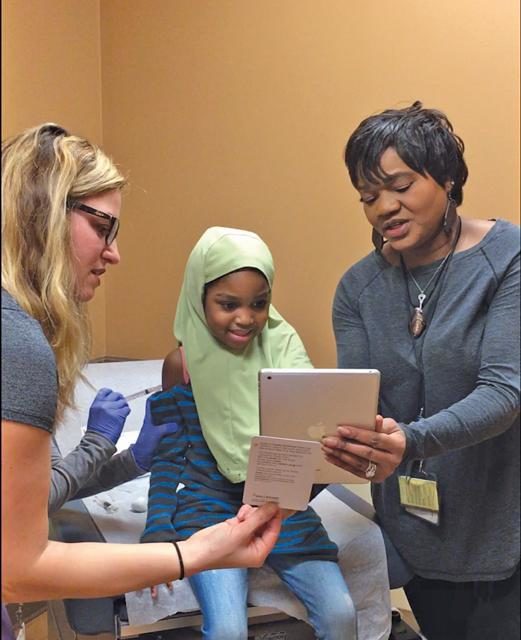Any parent can relate to what came next: a trip to the ER, and lots of anxiety. Because the girl was so young, staff had to strap her to a papoose board to hold her down, followed by general anesthesia in the OR, just to use tweezers to remove the object.
“When you’re a parent, you’re anxious enough about your child,” York says of the incident two years ago, “and all of a sudden, they’re having to pin your child down, and it’s traumatizing her. But, what else can they do?”
York found the answer in her own company, Spellbound. She’d founded it in 2016 to develop an app that added interactive features to children’s books. Just scan a barcode on a book, and all kinds of cool interactive 3-D characters would pop up on your phone. It was a great tool for engaging kids with learning. But after that ER visit and a conversation with a friend in health care, York saw a more pressing need.
Spellbound pivoted to focus on reducing children’s anxiety during medical procedures. Once the app is installed on an iPad, a caregiver just has to point the tablet’s camera at a Spellbound printout card to make a 3-D animal such as an elephant pop up above the card on the screen. The caregiver can then engage with the animal interactively. Point it at another card, and a story unfolds about a castle. Doctors, therapists, and child life specialists can use the animations to create narratives with a child about a medical procedure, or to distract them while they’re getting a shot or an IV.
“We found that using a learning app and storytelling narratives to distract children during medical procedures greatly reduces the need for extreme medical interventions such as restraints or general anesthesia during simple procedures,” York says. With her own child and others, she says, it’s made the difference between feeling extreme anxiety and not even noticing a procedure.
J.J. Bouchard, patient technology coordinator at Mott Children’s Hospital, has added Spellbound to the tools the hospital uses to distract and engage young patients. “My job is to bring technology like video games, virtual reality, and augmented reality to help doctors, therapists, and child life specialists integrate that into their practice,” he explains. “We use the tech to brighten up their day, to wake them up, get them excited.”
Bouchard describes watching a Mott child life specialist use Spellbound to comfort a child before surgery. The specialist was trying to explain what to expect, and the child was nearly inconsolable. But when the specialist brought out her iPad and a Spellbound character popped out, the child stopped crying, engaged in the story, and began asking about the characters. They walked back to surgery with the story running, and the child excited and happy.
Bouchard says that Spellbound can also encourage kids who are working to improve arm or fine motor movements. One day he would love to see bigger images that spread over whole walls or windows as virtual reality posters that kids can engage with–not only for distraction or motivation, but to encourage them through rough patches in treatment.
York says that Spellbound’s technology is also useful for more mundane situations. “Just think about how many needle-related medical procedures such as vaccines that even a healthy child has to go through in a lifetime,” she says. “It doesn’t just create phobias. It leads to [adults] resisting health care that could save them trouble down the road, such as a person who delays seeing a doctor because they might need an IV.”
“You have enough anxiety about your child needing a medical procedure,” she says. “This is the difference between pinning them down and letting them play.”
